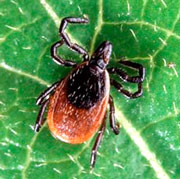Are there deer ticks in Tompkins County?
Yes. The deer tick population in Tompkins County has grown over the last decade. Through passive surveillance done by Tompkins County Health Department (TCHD) from 2007–2008, total Tompkins County deer tick submissions increased from 128 in 2007 to 270 in 2008. The number of Lyme disease cases reported in Tompkins County increased nearly 60% from 2009 to 2010.
Can I get Lyme disease from a tick from Tompkins County?
Yes. The New York State Department of Health (NYSDOH) Arthropod-Borne Disease Program has estimated that approximately an average of 20% of deer ticks in Tompkins County and throughout New York State are infected with the causative organism, B. burgdorferi.
Preliminary data from a NYSDOH 3-year Calvary Cemetery active tick surveillance shows that the causative agent for Lyme disease, Borrelia burgdoferi, is present in Tompkins County. Of the autumn 2008 sample set of 50 adult deer ticks analyzed, 30% had the Lyme disease bacteria present. The infection rate of 30% is similar to the high infection rate observed in adult ticks from the greater Albany area and in counties along the lower Hudson River. These infection rates are among the highest rates in New York state.
46 cases of Lyme disease were found in Tompkins County residents during 2008 compared to 9 in 2007. The difference from 2007 to 2008 in number of Lyme disease cases may be due to better physician reporting of erythema migrans rash diagnoses, improved data collection from physicians for those tested for Lyme disease, as well as the increase in the Tompkins County deer tick populations along with the increasing infection rates in Tompkins County ticks. In 2010 there were 70 Lyme disease cases found in Tompkins County.
Are infected deer ticks present in the same numbers everywhere in the county?
No. The numbers of deer ticks and the numbers of infected deer ticks will vary from location to location in the county.
How can I prevent Lyme disease?
Avoid tick bites. Wear light colored clothing and tuck pant legs into socks. Apply insect repellant to clothing. Examine clothing and skin for ticks after spending time outside. The risk of Lyme disease transmission is reduced if ticks are removed within 36 hours of attachment. Perform a daily tick check following outside activity and remove all ticks.
What should I do if I find a deer tick attached to me?
Carefully remove attached ticks immediately. Remove by grasping the mouth parts of the tick as close to the skin as possible with tweezers and gently pull the tick out in a steady, upward motion. Disinfect the site with soap and water. Do not use kerosene, petroleum jelly or a match to remove the tick.
What should I do if the head or mouthparts of the tick remain attached after I pull off the body of the tick?
Disinfect the site with soap and water. The tick will not continue to transmit disease if infected with Lyme disease, and the head should fall out on its own. If you are concerned about the site, contact your health care provider.
What should I do with the tick after I remove it?
Although not routinely recommended, taking antibiotics within three days after a tick bite may be beneficial for some persons. This would apply to deer tick bites that occurred in areas where Lyme disease is common and there is evidence that the tick fed for more than one day. In cases like this you should discuss the possibilities with your doctor or licensed health care provider.
How big are deer ticks? When are they active?

Nymphs are active May through July and are poppy seed size. Nymphs can be difficult to find attached, thereby making the nymphal life state most likely to transmit Lyme disease due to a less timely removal of the nymphal tick.
Adult ticks are active in late winter, early spring and again in the fall and are about the size of a sesame seed.
Factsheet
Testing a Tick for the Lyme Disease pathogen (PDF, 243K)
Guide for Preventing Lyme Disease (NYSDOH):
» PDF download (542KB)
» Web Page (NYSDOH site)

